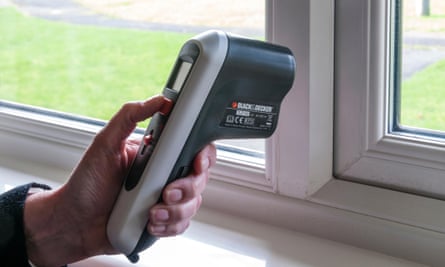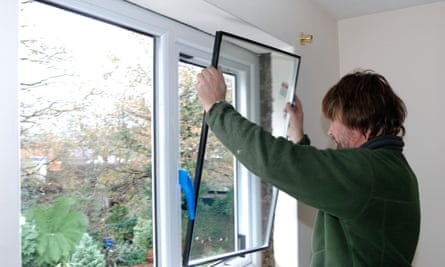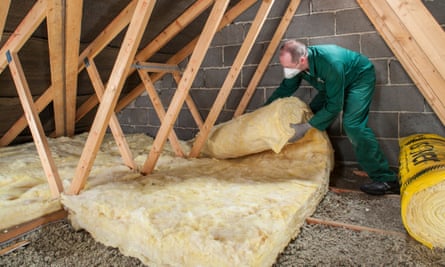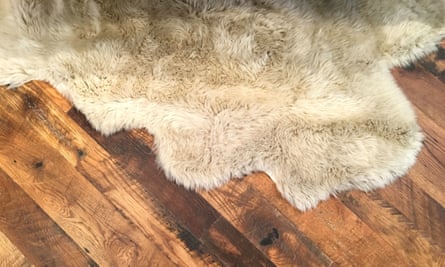This winter is expected to be particularly challenging for UK households, thanks to steep rises in energy bills and other essential costs. The average household can expect to pay £2,500 a year for its energy after the government’s cap on unit prices, and potentially far more, depending on the size of its home and usage. Many people may struggle to cover basic costs such as food and heating over the coming months.
So it is more important than ever to plan ahead to make your home warmer and more energy-efficient. Here’s what you can do now – from simple DIY changes to more expensive measures.
1. Find where heat escapes
 View image in fullscreenA thermal leak detector can help find air escapes. Photograph: UrbanImages/Alamy
View image in fullscreenA thermal leak detector can help find air escapes. Photograph: UrbanImages/Alamy
You need to find where warm air is escaping from your home and cold air is coming in. Places that may let in draughts include windows, doors, floorboards, chimneys and loft hatches.
Hold a candle near windows, doors and other areas to see if the flame dances around, suggesting a leak. Alternatively, try a thermal leak detector, such as the Black & Decker TLD100. You can buy this for £48.95 or rent one for just £5 a day on the Fat Llama marketplace. This flashes blue for cold, green for normal and red for warm, so you know where there are air leakages.
2. Draught-proof your doors
It’s worth draught-proofing your internal and external doors. For gaps at the bottom of the front and back doors, the most durable choice is a “brush” draught-excluder. You can make your own draught-excluders for internal doors using rolled-up towels, or tights filled with old clothes, or buy cheap or second-hand draught-excluders on sites such as eBay.
You can buy rubber draught seals from DIY stores and fit these around the sides of your external doors. Install metal keyhole-covers, and fit a letterbox brush to keep the heat in your home.
3. Plug unused chimneys
If there’s a chimney you’re not using, stop the hole with an inflatable chimney balloon, available online for £20 or so – or create a DIY plug with balls of newspaper or old pillows. The Energy Saving Trust (EST) estimates that installing a chimney draught-excluder can save about £65 a year on your energy bills.
4. Seal your windows
 View image in fullscreenCling-film on the inside of window frames can help keep your home warm. Photograph: Cirkoglu/Alamy
View image in fullscreenCling-film on the inside of window frames can help keep your home warm. Photograph: Cirkoglu/Alamy
Members of the Facebook group Energy Support and Advice UK use clingfilm fixed on to the inside of window frames to keep their homes warm. You can also buy purpose-made “secondary-glazing film” online for about £10, and shrink it to fit your frame using a hairdryer.
Alternatively, fit a layer of glass or plastic inside your window frame as a cheaper alternative to ready-made double-glazing. If you are unable to change your windows because, for example, you live in a conservation area, this may be a solution. You can also fit self-adhesive foam strips to seal around windows and prevent air leakages.
5. Install double-glazing
 View image in fullscreenProfessionally installed double-glazing can be expensive but will add to the value of your home. Photograph: Paul Glendell/Alamy
View image in fullscreenProfessionally installed double-glazing can be expensive but will add to the value of your home. Photograph: Paul Glendell/Alamy
A more expensive option is purpose-built double-glazing, which will improve the energy efficiency of your home and could add to its value. Depending on where you live, you can expect to pay between £750 and £1,500 to replace each sash window, and an average of £660 each for casement windows.
You may be able to keep existing frames to reduce the cost, and fit double-glazed panes. The EST recommends double-glazed glass with an energy rating of B or above. Find a registered installer at Fensa.
6. Put up thermal curtains
 View image in fullscreenReady-made thermal curtains start at £14.99. Photograph: Africa Studio/Alamy
View image in fullscreenReady-made thermal curtains start at £14.99. Photograph: Africa Studio/Alamy
Closing your curtains when it starts getting dark stops heat escaping through your windows. Ideally, you want heavy-duty thermal lined curtains. You can find ready-made options online from £14.99. Fitting a thermal curtain across the inside of front and back doors can significantly reduce heat loss. You can also sew thermal linings to existing curtains – or add them using Velcro.
7. Insulate your loft
 View image in fullscreenLoft insulation can save £355 a year on energy bills, says the Energy Saving Trust. Photograph: Chris Henderson/Getty Images
View image in fullscreenLoft insulation can save £355 a year on energy bills, says the Energy Saving Trust. Photograph: Chris Henderson/Getty Images
According to the EST, an insulated loft can save up to £355 a year on energy bills in a semi-detached house, rising to £590 for a detached house. If your loft is easily accessible, you can do the work yourself using rolls of mineral wool that lie between the joists. There are videos online that show how to fit this. It costs about £630 to insulate a loft in a detached house, according to the EST, £480 for a semi, and £455 for a terraced house.
Some energy suppliers offer free loft insulations under the energy company obligation (ECO) scheme to reduce carbon emissions and help households in fuel poverty. You usually need to receive a benefit such as universal credit or child tax credit to qualify.
8. Insulate walls
A third of all heat lost in homes is through uninsulated walls, according to the EST. If your home was built after the 1920s, it probably has cavity walls, which lose less heat than solid walls. You will need an installer to drill holes and inject insulating material into cavity walls. Costs range from about £395 to £1,800, depending on the size of your property, according to the EST.
Eligible households may qualify for free cavity-wall insulation under the ECO scheme (see above). Bear in mind that cavity walls in homes built since the 1990s are usually already insulated.
Older, solid walls lose the most heat, and homes with these are less likely to be insulated – and it’s trickier and pricier to do the job. If you fit internal wall insulation, it’s cheaper, but you’ll reduce your floor space. External wall insulation entails fitting insulation boards to the outside of your home. Either way, the cost can add up – to about £8,500 for internal solid wall insulation for a semi-detached house, rising to £12,000 for external wall insulation.
9. Install radiator reflector panels
Ensure heat from your radiators is reflected back into the room instead of being lost into the wall by fitting reflector panels behind them, particularly if they back on to exterior walls. A pack of three sheets from Radflek will fit three to six radiators, with fixing clips and strips included, for £21.99 – or make your own using cardboard and kitchen foil.
10. Bleed your radiators
 View image in fullscreenA radiator valve key for bleeding costs about £1. Photograph: Rob Wilkinson/Alamy
View image in fullscreenA radiator valve key for bleeding costs about £1. Photograph: Rob Wilkinson/Alamy
Ensuring there’s no air trapped in your radiators will keep your central heating system running efficiently.
Simon Oram, category manager at Toolstation, says: “You can check whether a radiator needs bleeding by turning it on and running your hands over it. Is it cooler at the top? This suggests there’s air trapped in the radiator. This can affect its efficiency, meaning it can take longer to warm up your room.” You can find guides on how to bleed your radiators on YouTube. You will need some old towels to soak up water, a small bowl and a radiator valve key, which costs about £1.
11. Tackle floorboard gaps and insulation
 View image in fullscreenPlace a rug over floorboard gaps to keep heat in. Photograph: bradleyhebdon/Getty Images/iStockphoto
View image in fullscreenPlace a rug over floorboard gaps to keep heat in. Photograph: bradleyhebdon/Getty Images/iStockphoto
Even small gaps between floorboards can let in cold draughts, but there are plenty of cheap ways to fill these, such as silicone sealant from DIY stores. If you don’t have the time or inclination to tackle the gaps, placing a rug on top of floorboards will make your home feel warmer.
If you’re able and willing to spend more, you can insulate the ground floor. This involves laying insulation on top of concrete floors, or mineral wool between the joists under suspended timber floors. According to Checkatrade, it costs £1,400 to insulate the average floor – but this depends on the type you have and the size of your home.
12. Check your room layout
Ensure sofas or beds aren’t placed right in front of radiators, preventing the warm air from circulating. If possible, also keep them away from windows and doors, so you don’t feel any draughts when you’re using them.
13. Get your boiler serviced – or upgrade it
You should ideally get your boiler serviced every 12 months, at a cost of between £60 and £120, and preferably before winter arrives, to ensure it is running efficiently and safely. If your boiler is sluggish, it will need to work harder to bring your home up to the desired temperature.
Switching to a new boiler is a big upfront cost, but the most efficient A-rated condensing models will reduce your energy bills. You could save up to £380 a year if you live in a semi and you are replacing an F-rated boiler, the EST estimates. Costs for replacing a boiler vary, but you can expect to pay about £4,000 to fit a new energy-efficient model.
14. Manage your thermostat
 View image in fullscreenA programmable thermostat gives more control of heating use. Photograph: Peter Dazeley/Getty Images
View image in fullscreenA programmable thermostat gives more control of heating use. Photograph: Peter Dazeley/Getty Images
Think about when you really need your heating on. You could set it to come on, for example, for an hour in the evening, and shortly before you get up. You could invest in a programmable thermostat that you control from your smartphone, such as Nest (£190). This enables you to turn the heating off when you are not at home, and on before you return.
Consider turning your thermostat down by 1C compared with last winter. You may not notice the difference but this could reduce energy bills by 10%, according to the EST.
15. Insulate your water tanks and pipes
 View image in fullscreenPipes running to the hot-water tank need to be insulated. Photograph: Laurence Berger/Getty Images/iStockphoto
View image in fullscreenPipes running to the hot-water tank need to be insulated. Photograph: Laurence Berger/Getty Images/iStockphoto
Check your hot-water tank has a lagging jacket to retain the heat. If you need to insulate it, you can pick up cylinder jackets for about £15. The pipes that run to and from the tank also need to be insulated, using foam tubes. These can also prevent your pipes freezing in extreme temperatures.




Leave a Reply
You must be logged in to post a comment.